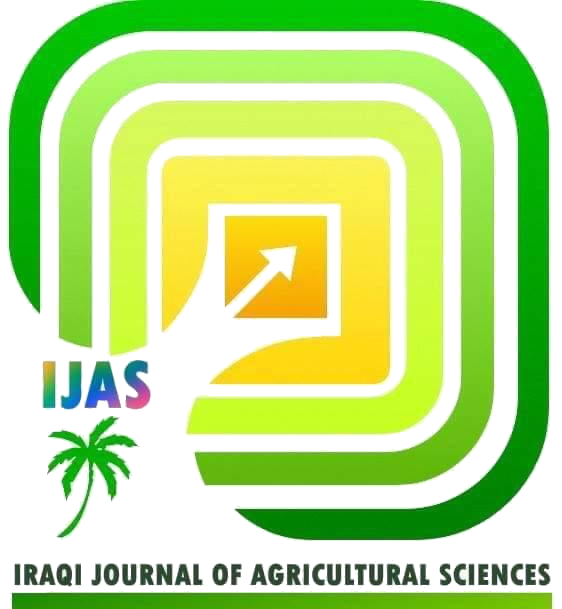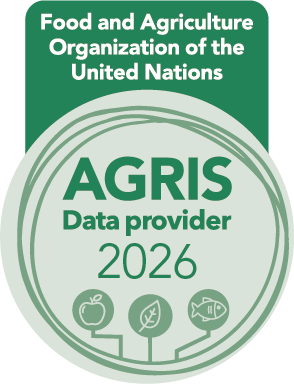DETERMINING THE WATER REQUIREMENT OF GROUNDNUT UNDER DIFFERENT IRRIGATION SYSTEMS AND IRRIGATION INTERVALS
DOI:
https://doi.org/10.36103/ejmvxp19Keywords:
peanut, yield, Orgevit fertilizer, irrigation scheduleAbstract
Three field experiments were conducted in Al- Rashidiya region, Istiqlal district, north of Baghdad governate, to study the difference the irrigation interval under subsurface drip, sprinkler, and furrow irrigation systems in water requirement and yield of peanut (Arachis hypogaea L.) during the summer season 2021.Three field experiments were conducted, each including three irrigation systems, subsurface drip irrigation, sprinkler irrigation, and furrow irrigation. It was implemented as a Factorial experiment within the design of Nested-Factorial Experiments Design. Where the second factor distributed three irrigation intervals on the main plot (2-day, 4 day and 6 day), then the three factors were divided into four replicates in which the levels of organic fertilization under every system (control, 2000 kg ha-1 Orgevit fertilizer and 4000 kg ha-1 Orgevit fertilizer). The seasonal water consumption of peanut under the subsurface drip irrigation system at the irrigation intervals 2, 4, and 6 days were 362.34, 362.35, and 362.06 mm, respectively. The seasonal water consumption of peanut, calculated under the sprinkler irrigation system at irrigation intervals 2, 4 and 6 days, was 507.02, 507 and 505.63 mm, respectively. The seasonal water consumption of peanut under furrow irrigation at irrigation intervals 2, 4 and 6 on day 583.44, 584.88 and 583.35 mm, respectively. The average total yield of Peanut pods increases by 25% and 33.43% under furrow and subsurface drip irrigation system respectively compared to a sprinkler system.
References
1.Abd El-Hady, M. and M. Shehata, 2024. Effect of mineral and organic fertilization rates under magnetized water irrigation on growth, yield, and quality of crisphead lettuce. Egyptian Journal of Soil Science, 64, p.1670.
doi: 10.21608/EJSS.2023.240320.1670.
2.Ahmed, S. A. 2020. Growth evaluation, grain yield and productivity of irrigation water for two varieties of barley materials under different irrigation levels. AIP Conference Proceedings 2235, 020029 (2020);
https://doi.org/10.1063/5.0008855.
3.Al-Ansari, N. 2021. Water Resources of Iraq. Journal of Earth Sciences and Geotechnical Engineering, 11(2): 15-34.
doi: 10.47260/jesge/1122.
4.Allen, R. G., L.S. Pereira, D. Raes, and M. Smith. 1998. Crop evapotranspiration, Irrigation and drainage paper N. 56. FAO-Food and Agriculture Organization of the United Nations: Rome, Italy.
5.Al-Mamouri, L. and M. Abdul Latif. 2015. Knowledge of the cultivation of Peanut crop by bush damage that affects the crop and methods of controlling it in Jalawla district /Diyala governorate. Diyala Journal of Agricultural Sciences 7 (1): 72-86.
6.Al-Taey, D. K. and A. Burhan. 2022. The effect of water quality, cultivar, and organic fertilizer on growth and yield of volatile oil carvone and limonene in Dill. International Journal of Vegetable Science, 28(4), pp.342-348. doi: 10.1080/19315260.2021.1970075.
7.Alwazzan, T. T., and A. S. Ati. 2024. Assessment of soil quality and health using some physical and biological properties for fadak farm projects. Iraqi Journal of Agricultural Sciences, 55(3), 1011-1024. https://doi.org/10.36103/ddeegt17
8.Aslan, N., N., Kalkancı, A., Yılmaz, and K. Sarpkaya. 2018. The effect of organic fertilizer applied with mineral fertilizer on pistachio productivity. In third International Horticultural Congress IHC 2018: II International Symposium on Organic Horticulture for Wellbeing.1286 :199-204.
doi: 10.17660/ActaHortic.2020.1286.28
9.Ati, A. S., S. S. Dawod, and K. M. Madlol. 2025. Sustainability of the water requirement of two okra under the use of cover crops and minimum tillage system. Iraqi Journal of Agricultural Sciences, 56(Special),161168.
https://doi.org/10.36103/vdh0jv08.
10.Ati, A.S., A., Hassan, S. Abd-Aljabar, and A. Salah. 2017. Role of bio fertilization on wheat and water productivity under water scarcity. Pak. J. Biotechnol, 14(4), pp.521-525.
11.Balasubramanian, P., R., Babu, C. R.,Chinnamuthu, K. Kumutha and P. Mahendran. 2020. Influence of irrigation scheduling and nutrient application on water use, productivity and profitability of groundnut (Arachis hypogaea L.). Legume Research-An International Journal, 1-7.
doi: 10.18805/LR-4466.
12. Black, G. R. 1965. Methods of soil snalysis, part 1, American Society of Agronomy.
13. Chaganti, V., G. Ganjegunte, G. Niu, G., Ulery, R. Flynn, J. Enciso, M. Meki, and J. Kiniry. 2020. Effects of urban wastewater irrigation on bioenergy sorghum and soil quality. Agricultural Water Management, 228, p.105894. doi:10.1016/j.agwat.2019.105894.
14.Cong, P., P. Huang, and Z. Huang. 2025. The response of soil microbial community to the application of organic amendment to saline land. Frontiers in Microbiology, 15, p.1481156.doi:10.3389/fmicb.2024.1481156.
15.Dawod, S. S., Ati, A. S., and I. Abdujabbar. 2024. Management of using saline irrigation water and tillage systems on the soil mechanical and hydraulic. Iraqi Journal of Agricultural Sciences, 55(6), 2050-2059. https://doi.org/10.36103/5b2srn23
16. El-Bauome, H.A., Abdeldaym, E.A., Abd El-Hady, M.A., Darwish, D.B.E., Alsubeie, M.S., El-Mogy, M.M., Basahi, M.A., Al-Qahtani, S.M., N. Al-Harbi, F. Alzuaibr, and A. Alasmari. 2022. Exogenous proline, methionine, and melatonin stimulate growth, quality, and drought tolerance in cauliflower plants. Agriculture, 12(9), p.1301. doi.org/10.3390/agriculture12091301
17.Food and Agriculture Organization of the United Nations (FAO). 2021. Global assessment of salt-affected soils. Food and Agriculture Organization of the United Nations. Available at: https://www.fao.org/newsroom/detail/fao-launches-first-major-global-assessment-of-salt-affected-soils-in-50-years/en.
18.Gruszecki, R., A. Stawiarz, and M. Walasek-Janusz. 2022. The effects of proline on the yield and essential oil content of turnip-rooted parsley (Petroselinum crispum ssp. tuberosum). Agronomy, 12(8), p.1941.doi.org/10.3390/agronomy12081941
19.Grzebisz, W., A. Gransee, W. Szczepaniak, and J. Diatta. 2020. The effects of potassium fertilization on water‐use efficiency in crop plants. Journal of Plant Nutrition and Soil Science, 176(3), pp.355-374.
doi: 10.1002/jpln.201200287
20. Guo, X., Du, S., Guo, H. and Min, W., 2023. Long-term saline water drip irrigation alters soil physicochemical properties, bacterial community structure, and nitrogen transformations in cotton. Applied Soil Ecology, 182, p.104719. doi.org/10.1016/j.apsoil.2022.104719.
21. Hajim, A. Y. and H. I. Yassin. 1992. Field Irrigation Systems Engineering. Dar Al-Kutub for printing and publishing. University of Al Mosul.
22.Hajim, F. A. S. 2012. Field irrigation is an introduction to the best resilience in advanced irrigation management applications. College of Agriculture. University of Baghdad. Ministry of Higher Education and Scientific Research. Iraq.
23.Imran, K.H.A.N., M. Iqbal, Mahmood, R. Maqbool, R., A. Muqarrab, M. Aslam, M. Hanif, S. Kohli, N. Sally, M. Moustafa, and M. Chattha. 2022. Foliar applied proline and acetic acid improves growth and yield of wheat under salinity stress by improving photosynthetic pigments, physiological traits, antioxidant activities and nutrient uptake. Notulae Botanicae Horti Agrobotanici Cluj-Napoca, 50(3), pp.12820-12820. doi: https://doi.org/10.15835/nbha50312820
24.Israelsen, O.W. and E. V. Hansen. 1962. Irrigation Principles and Practices. 3rd Edition, Wiley International Edition, New York.
25.JICA. 2016. Data Collection Survey on Water Resource Management and Agriculture Irrigation in the Republic of Iraq. Final Report, Japan International Cooperation Agency (JICA), NTC International Co., Ltd.
26.Khamees, A. A. H., A. S. Ati, and H. Hussein.2023. Effect of Surface and Subsurface Drip Irrigation and Furrows Irrigation System on Water Productivity, Growth and Yield of Lettuce (Lactuca Sativa L). In IOP Conference Series: Earth and Environmental Science (Vol. 1158, No. 2, p. 022009). IOP Publishing. doi: 10.1088/17551315/1158/2/022009.
27. Ma, L., Guo, H. and W. Min. 2019. Nitrous oxide emission and denitrified bacteria communities in calcareous soil as affected by drip irrigation with saline water. Applied Soil Ecology, 143, pp.222-235.
doi.org/10.1016/j.apsoil.2019.08.001.
28.Mandeewal, R. L., M. L., Soni, I. J., Gulati, N. D., Yadava, and V. NANGIYA. 2022. Effect of irrigation and nitrogen on yield and water productivity of groundnut (Arachis hypogaea) and clusterbean (Cyamopsis tetragonoloba). Annals of Plant and Soil Research, 24(2): 282-287.
doi: 10.47815/apsr.2022.10162.
29. Ministry of Planning. 2020. Central Statistical Organization / Agriculture / Production of Secondary Crops and Vegetables Report by Governorate. Planning Department / Agricultural Planning Department.
30.Sesveren, S. and B. Taş. 2022. Response of Lactuva Sativa Var. Crispa to deficit irrigation and leonardite treatments. All Life, 15(1), pp.105-117. doi.org/10.1080/26895293.2021.2024892.
31.Shuite, Z., A.Demessie, and T. Abebe, 2025. Land use effect on soil quality and its implication to soil carbon storage in Aleta Chuko, Ethiopia. Geoderma Regional, 40, p.e00917.
doi.org/10.1016/j.geodrs. 2025.e00917.
32.Soil Survey. 2014. Keys to soil Taxonomy. Agriculture Dept. (U. S.).
33.Somenahally, A.C., J. McLawrence, V. Chaganti, G. Ganjegunte, O. Obayomi, and J. Brady. 2023. Response of soil microbial
Communities, inorganic and organic soil carbon pools in arid saline soils to alternative land use practices. Ecological Indicators, 150, p.110227.
doi.org/10.1016/j.ecolind.2023.110227.
34.Tedeschi, A., Schillaci, M. and R. Balestrini. 2023. Mitigating the impact of soil salinity: recent developments and future strategies. Italian Journal of Agronomy, 18(2), p.2173. doi.org/10.4081/ija.2023.2173.
35.Yassin, F.B., M. Aliwi, and S. Mahmood. 2023, December. Effect of Adding Chelated Zinc and Vermicompost on Some Indicators of Maize Growth. In IOP Conference Series: Earth and Environmental Science (Vol. 1262, No. 8, p. 082029). IOP Publishing.
doi 10.1088/1755-1315/1262/8/082029.
Downloads
Published
Issue
Section
License
Copyright (c) 2025 IRAQI JOURNAL OF AGRICULTURAL SCIENCES

This work is licensed under a Creative Commons Attribution-NonCommercial-NoDerivatives 4.0 International License.

2.jpg)


